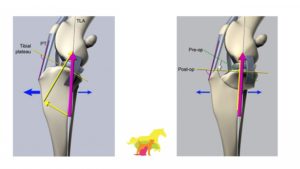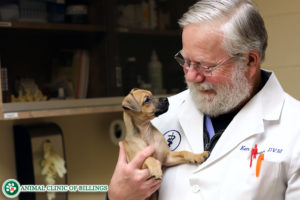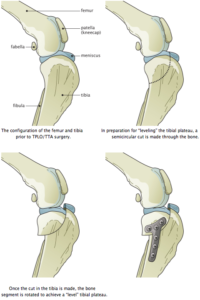TPLO surgery
 TPLO Surgery on Dogs – Stage 1
TPLO Surgery on Dogs – Stage 1
Goals of TPLO surgery:
- Reduce lameness and inflammation
- Improve use of limb
- Improve daily functions
- Prevent further injuries
Benefits of Exercise:
- Facilitates the rate of recovery
- Improves the quality of movement
- Noninvasive
Post-Operative TPLO TREATMENT
- Your dog needs to take it easy and have limited activity!
- Bandage removal/change in 5-7 days.
- Staple removal appointment in 10-14 days.
- A recheck and radiographs should be scheduled in 4-6 weeks.
Ice packs and warm packs
Once the bandage is removed the, surgically repaired limb should be iced 2-4 times daily to reduce swelling. Lay your dog on her side with the surgery limb up. Place a rolled towel between the limbs so the surgery limb is kept parallel to the floor. Place a lightweight towel between the limb and the ice pack. Ice should be applied for 10-15 minutes. Please plan to ice the surgery limb for 3-5 days following bandage removal, and then switch to warm packing. Warm packing should be done 2-3 times per day for 15-20 minutes each session.
Massage
Gentle massage will increase circulation & stimulate drainage. Lay your dog comfortably on her side with the surgery leg up. Begin with light strokes starting at the distal end of the limb. Stroke the limb gently in an upward, circular motion. Work your way up the entire limb. Please massage for approximately 10-15 minutes.
Passive Range of Motion (PROM) following massage is beneficial. PROM promotes healing, helps with recovery of soft tissue mobility, neuromuscular re-education and synovial movement. Gently grasp your dog’s paw and move the surgery limb in flowing, circular, forward to backward movements. Be sure to include a few stretches during the PROM exercises. Repeat for 10-15 repetitions 2-3 times daily. These exercises may be done lying or standing.
Gait Training
Your dog should remain quiet & confined to a small area or on a leash for a minimum of 8 weeks; she may go on slow leash walks. These should be done at a controlled and exaggerated slow pace. Please walk your dog on a flat surface two to three times a day for 5 minutes. Walks may be increased 1-2 minutes each week. Use positive praise when weight is put on the affected limb. Use ice following exercise for 10-15 min for the first 2 weeks.
Discourage any quick movements, cutting side-to-side, running, jumping or rough play with other dogs. Always be cognizant of excitability associated with visitors at the door, the mailman or other animals ( i.e. cats and squirrels). It may lead to a sudden burst of activity that could predispose the implant to loosening or luxation. In additions keep your dog on flat surfaces and avoid slippery surfaces.
Physical rehabilitation therapy (PRT)
Once the staples are removed, your dog could strongly benefit from physical rehabilitation therapy sessions on our Underwater Treadmill. The underwater treadmill is one of the most valuable pieces of equipment in aquatic therapy. Hydrotherapy can result in significant gains in strength, ROM, function, and overall cardiovascular fitness. We highly recommend our post-operative TPLO patients schedule hydrotherapy sessions 2 or 3 times weekly for the next 4-8 weeks.
Watch for any increased signs of lameness, decreased limb use or abnormal behaviors and tailor your dog’s exercises accordingly they are not overtaxed. If any lameness or decreased limb use occurs, please contact our hospital.
TPLO Surgery on Dogs – Stage 2
Below are some ideas that will help your pet to heal and return to function. These are guide lines feel free to do similar activities that may fit your life style better. Remember your pet should stay on a leash for at min of 10-12 weeks after TPLO surgery.
Goals:
- Increase limb use and reduce lameness
- Increase walk time and length for overall improvement
- Continue to improve muscle mass and strength
- Continue to improve stamina and endurance
Treatment:
- The intensity of your dog’s routine can be increased.
- Leash walks can be performed on a longer leash and for 25-30 minutes 3 times daily.
- Neuromuscular re-education can begin by walking on a trampoline, couch cushion, or inflatable mattress.
- Walk your dog in a figure 8 pattern or in circles to the left then the right to encourage weight bearing on the surgery limb.
- To strengthen the rear limb muscles, your dog may start doing sit to stand exercises. Walk your dog along a wall or fence line with the surgery limb on the side of the wall/fence. Ask your dog to sit then stand. Repeat 10 times 3 times daily. The purpose of having the limb against the wall is to have a brace they can push against as they rise.
**During this stage of rehabilitation some mild lameness may be apparent, and prolonged activity may worsen the lameness. If lameness occurs, anti–inflammatory medication should be given. A 1-2 day rest should be given followed by a reduced level of activity (50-70% of what it was prior to the lameness) for a few days then gradually work back up to previous level of activity.**

Let our highly trained and experienced team of veterinarians and veterinary technicians help you keep your dog as happy and healthy as they can be.
Call the Animal Clinic of Billings and Animal Surgery Clinic to schedule your pet cat’s next wellness examination with one of our veterinarians today!




